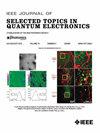Study of the Conduction Mechanism in Si-Based Light-Initiated Multi-Gate Semiconductor Switches
IF 5.1
2区 工程技术
Q1 ENGINEERING, ELECTRICAL & ELECTRONIC
IEEE Journal of Selected Topics in Quantum Electronics
Pub Date : 2025-03-16
DOI:10.1109/JSTQE.2025.3570698
引用次数: 0
Abstract
In this paper, software is used to simulate the conduction characteristics of silicon-based light-initiated multi-gate semiconductor switches. The switching processes of silicon-based light-initiated single-gate semiconductor switches and multi-gate semiconductor switches are compared. The transient state distribution characteristics of carriers during the switching process are analyzed, and the transport mechanism of carriers in the switches is investigated. The electron–hole pairs generated by a laser in the P-base region undergo both transverse diffusion and longitudinal transmission. The light-initiated multi-gate semiconductor switches exhibit shorter carrier transverse diffusion times and larger opening areas, resulting in increased maximum current and the current response speed after switch conduction. Moreover, we analyze the influence of different laser energies and distributions modes on the light-initiated multi-gate semiconductor switch. Lower laser energy activates the J1 junction but cannot trigger the J3 junction of the switch. Consequently, the carrier concentration remains low, and the switch does not fully open. Compared with a 980 nm laser diode (with a pulse width of 200 ns), a 980 nm Gaussian laser (with a half-peak width of 10 ns) enables faster switch activation.硅基光引发多栅半导体开关的传导机制研究
本文利用软件模拟了硅基光引发多栅半导体开关的传导特性。比较了硅基光启动单门半导体开关和多门半导体开关的开关过程。分析了开关过程中载流子的暂态分布特性,研究了开关中载流子的输运机理。激光在p基区产生的电子-空穴对同时经历横向扩散和纵向传输。光引发多栅半导体开关具有载流子横向扩散时间短、开孔面积大的特点,从而提高了开关导通后的最大电流和电流响应速度。此外,我们还分析了不同的激光能量和分布模式对光引发多栅半导体开关的影响。较低的激光能量激活J1结,但不能触发开关的J3结。因此,载流子浓度仍然很低,开关不能完全打开。与脉冲宽度为200 ns的980 nm激光二极管相比,980 nm高斯激光器(半峰宽度为10 ns)的开关激活速度更快。
本文章由计算机程序翻译,如有差异,请以英文原文为准。
求助全文
约1分钟内获得全文
求助全文
来源期刊

IEEE Journal of Selected Topics in Quantum Electronics
工程技术-工程:电子与电气
CiteScore
10.60
自引率
2.00%
发文量
212
审稿时长
3 months
期刊介绍:
Papers published in the IEEE Journal of Selected Topics in Quantum Electronics fall within the broad field of science and technology of quantum electronics of a device, subsystem, or system-oriented nature. Each issue is devoted to a specific topic within this broad spectrum. Announcements of the topical areas planned for future issues, along with deadlines for receipt of manuscripts, are published in this Journal and in the IEEE Journal of Quantum Electronics. Generally, the scope of manuscripts appropriate to this Journal is the same as that for the IEEE Journal of Quantum Electronics. Manuscripts are published that report original theoretical and/or experimental research results that advance the scientific and technological base of quantum electronics devices, systems, or applications. The Journal is dedicated toward publishing research results that advance the state of the art or add to the understanding of the generation, amplification, modulation, detection, waveguiding, or propagation characteristics of coherent electromagnetic radiation having sub-millimeter and shorter wavelengths. In order to be suitable for publication in this Journal, the content of manuscripts concerned with subject-related research must have a potential impact on advancing the technological base of quantum electronic devices, systems, and/or applications. Potential authors of subject-related research have the responsibility of pointing out this potential impact. System-oriented manuscripts must be concerned with systems that perform a function previously unavailable or that outperform previously established systems that did not use quantum electronic components or concepts. Tutorial and review papers are by invitation only.
 求助内容:
求助内容: 应助结果提醒方式:
应助结果提醒方式:


